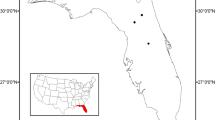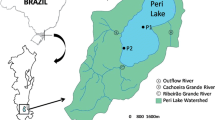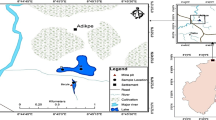Abstract
We conducted a geochemical analysis on three sediment cores collected from soda and freshwater lakes in the Pantanal region, in Brazil. Our objective was to identify the primary sources of organic matter associated with the Pleistocene-Holocene transition, as previously documented in that area. The Nhecolandia region, located in the Pantanal, encompasses over 10,000 lakes, with approximately 10% of them exhibiting alkaline characteristics. Soda lakes became highly saline and alkaline after ~ 910 cal yr BP, which influences biogeochemistry and aquatic ecology. They have high electrical conductivity and pH can reach 10.5. In contrast to freshwater, soda lakes are absent of surrounding vegetation. Literature suggests a strong influence by the Last Glacial Maximum on the region. We hypothesized that periods of aridity and increased precipitation influenced the composition of organic matter present in sediments and preserved within these cores. Our analysis focused on examining the presence and distribution of fatty acids, organic carbon content, and total nitrogen. In general, the cores exhibited two distinct parts in terms of organic matter sources: the upper sections of the cores were primarily composed by terrestrial sources, identified by the presence of long-chain fatty acids, while the deeper sections were dominated by aquatic sources, therefore short-chain fatty acids. We did not find significant difference among fatty acid profile that could distinguish freshwater from soda lakes, the only remarkable difference was the occurrence of saturated fatty acids, which is lower in freshwater lake. These findings suggest the occurrence of humid and arid periods in the region. The C/N ratio displayed a similar trend to the fatty acid’s profiles, exhibiting an abrupt change that was likely induced by climate variations. Although diagenesis can alter the composition of organic matter and, subsequently, the C/N values, it is noteworthy that the abrupt change observed in the Salina da Ponta (soda lake) core corresponds to 3,200 years BP. This coincides with documented climate changes that occurred during the Holocene. Our study revealed the influence of past climatic conditions on the sources and variations of organic matter in sediment cores from the Pantanal’s soda and freshwater lakes. Consideration of diagenesis and climate variations is crucial for interpreting sedimentary records.








Similar content being viewed by others
Data availability
The authors declare that all other data supporting the findings of this study are available within the article and its supplementary information files.
References
Almeida BC, Araújo BQ, Barros EDS et al (2017) Dammarane triterpenoids from carnauba, Copernica prunifera (Miller) H. E. Moore (Arecaceae), wax. J Braz Chem Soc 28:1371–1376. https://doi.org/10.21577/0103-5053.20160308
Arnold TE, Kenney WF, Curtis JH et al (2018) Sediment biomarkers elucidate the Holocene ontogeny of a shallow lake. Plos One 13:e0191073. https://doi.org/10.1371/journal.pone.0191073
Ashley K, Bendle J, Crosta X et al (2020) Fatty acid 1 carbon isotopes: a new indicator of marine Antarctic palaeoproductivity? Biogeosci Discuss. https://doi.org/10.5194/bg-2020-124
Assine ML, Silva A (2009) Contrasting fluvial styles of the Paraguay River in the northwestern border of Pantanal wetland, Brazil. Geomorphology 113:189–199. https://doi.org/10.1016/j.geomorph.2009.03.012
Barbiéro L, Berger G, Rezende Filho AA et al (2016) Organic control of dioctahedral and trioctahedral clay formation in an alkaline soil system in the Pantanal wetland of Nhecolândia, Brazil. PLoS One 11:1–23. https://doi.org/10.1371/journal.pone.0159972
Berggren M, Al-Kharusi ES (2020) Decreasing organic carbon bioreactivity in European rivers. Freshw Biol 65:1128–1138. https://doi.org/10.1111/fwb.13498
Bergier I (2013) Effects of highland land-use over lowlands of the Brazilian Pantanal. Sci Total Environ 463:1060–1066. https://doi.org/10.1016/j.scitotenv.2013.06.036
Bergier I, Krusche A, Guérin F (2014) Alkaline lake dynamics in the Nhecolândia landscape. In: Bergier I, Assine ML (eds) Dynamics of the Pantanal Wetland in South America. Springer International, Cham, Switzerland, pp 145–161
Blaaum M, Christen A (2011) Flexible paleoclimate age-depth models using an autoregressive gamma process. Bayesian Anal 6:457–474. https://doi.org/10.1214/11-BA618
Bligh EG, Dyer WJ (1959) A rapid method of total lipid extraction and purification. Can J Biochem Physiol 37:911–917. https://doi.org/10.1139/o59-099
Camacho-Ibar V, Avwytua-Alcazar L, Carriquiry JD (2003) Fatty acid reactivities in sediment cores from the northern Gulf of California. Org Geochem 34:425–439. https://doi.org/10.1016/S0146-6380(02)00211-5
Chavez-Lara CM, Holtvoeth J, Roy PD, Pancost RD (2019) Lipid biomarkers in lacustrine sediments of subtropical northeastern Mexico and inferred ecosystem changes during the late Pleistocene and Holocene. Palaeogeogr Palaeoclimatol Palaeoecol 535:109343. https://doi.org/10.1016/j.palaeo.2019.109343
Cohen AS (2003) Paleolimnology: the history and evolution of lake systems. Oxford University, Oxford
Cranwell PA (1981) The stereochemistry of 2- and 3- hydroxy fatty acids in a recent lacustrine sediment. Geochim Cosmochim Acta 45:547–552. https://doi.org/10.1016/0016-7037(81)90187-3
Daher S, Gülaçar F (2005) Geochemistry of carboxylic acids in the sediments from lake Cadagno (Switzerland). Arch Sci 58:25–42
Eglington G, Hamilton RJ (1967) Leaf epicuticular waxes. Science 156:1322–1335. https://doi.org/10.1126/science.156.3780.1322
Eglinton G, Calvin M (1967) Chemical fossils. Sci Am 216:32–43. https://doi.org/10.1038/scientificamerican0167-32
Froehner S, Martins RF (2008) Evaluation of the chemical composition of sediments from the Barigui River in Curitiba, Brazil. Quim Nova 31:2020–2026. https://doi.org/10.1590/S0100-40422008000800020
Fulco AJ (1967) Chain elongation, 2-hydroxylation and decarboxylation of long chain fatty acids by yeast. J Biol Chem 242:3608–3613. https://doi.org/10.1016/S0021-9258(18)95852-7
Gaskell SJ, Morris RJ, Eglington G, Calvert SE (1975) The geochemistry of a recent marine sediment off northwest Africa. An assessment of source of input and early diagenesis. Deep-Sea Res 22:777–789. https://doi.org/10.1016/0011-7471(75)90082-0
Goñi MA, Ruttemberg KC (1997) Phosphorus distribution, C:N: P ratios, and δ13Coc in arctic, temperate, and tropical coastal sediments: tools for characterizing bulk sedimentary organic matter. Mar Geol 139:123–145. https://doi.org/10.1016/S0025-3227(96)00107-7
Goossens H, Irene W, Rijpstra C et al (1986) Bacterial contribution to sedimentary organic matter; a comparative study of lipid in bacteria and recent sediments. Adv Org Geochem 10:683–696. https://doi.org/10.1016/S0146-6380(86)80004-3
Gradella FS, Zani H, Silva AS et al (2011) Geomorphology and deposition events in Nhecolândia Pantanal wetland. Geografia 36:107–117
Guerreiro RL (2016) Holocene paleoenvironmental changes in saline lakes of Nhecolândia, Pantanal wetland, Brazil. PhD Thesis. State University of Sao Paulo, Brazil
Guerreiro RL, McGlue MM, Stone JR et al (2018) Paleoecology explains Holocene chemical changes in lakes of the Nhecolândia (Pantanal-Brazil). Hydrobiologia 815:1–19. https://doi.org/10.1007/s10750-017-3429-3
Guerreiro RL, Bergier I, McGlue MM et al (2019) The soda lakes of Nhecolândia: a conservation opportunity for the Pantanal wetlands. Perspect Ecol Conserv 17:9–18. https://doi.org/10.1016/j.pecon.2018.11.002
Haddad RI, Martens CS, Farrington JW (1992) Quantifying early diagenesis of fatty acids in a rapidly accumulating coastal marine sediment. Org Geochem 19:205–216. https://doi.org/10.1016/0146-6380(92)90037-X
Hansel FA, Fossari TD, Madureira LAS (2008) Lipids in archaeological sediments – preliminary results of the archaeological site Rio do Meio, Santa Catarina Island (SC), Brazil. Rev Bras Cienc Solo 32:133–140. https://doi.org/10.1590/S0100-06832008000100013
Ho ES, Meyers PA (1994) Variability of early diagenesis in lake sediments: evidence from the sedimentary geolipid record in an isolated tarn. Chem Geol 112:309–324. https://doi.org/10.1016/0009-2541(94)90031-0
Holtvoeth J, Vogel H, Wagner B, Wolff GA (2010) Lipid biomarkers in Holocene and glacial sediments from ancient Lake Ohrid (Macedonia, Albania). Biogeos Discuss 7:4607–4640. https://doi.org/10.5194/bg-7-3473-2010
Hu ZL, Mendoza YA, Buchs A, Gülaçar FO (1988) Substituted fatty acids in the leaves of some higher plants. Lipids 23:679–681. https://doi.org/10.1007/BF02535667
Hua Q, Barbetti M, Rakoeski AZ (2013) Atmospheric radiocarbon for the period 1950–2010. Radiocarbon 55:2059–2072. https://doi.org/10.2458/azu_js_rc.v55i2.1677
Huguet A, Coffinet S, Roussel A et al (2019) Evaluation of 3-hydroxy fatty acids as a pH and temperature proxy in soils from temperate and tropical altitudinal gradients. Org Geochem 129:1–13. https://doi.org/10.1016/j.orggeochem.2019.01.002
Ishiwatari R, Hanya T (1975) Organic geochemistry of a 200-meter core sample from Lake Biwa II. Vertical distribution of mono and dicarboxylic acids and polynuclear aromatic hydrocarbons. Proc Jpn Acad 51:436–441. https://doi.org/10.2183/pjab1945.51.436
Jiménez AE, Schleder AA, Sanez J et al (2019) Use of fatty acids as tracer of organic matter input associated with level of land urbanization. Environ Sci Pollut Res 26(31):31685–31698. https://doi.org/10.1007/s11356-019-06257-w
Kawamura K, Ishiwatari R (1984) Fatty acid geochemistry of a 200 m sediment core from Lake Biwa, Japan. Early diagenesis and paleoenvironmental information. Geochim Cosmochim Acta 48:251–266. https://doi.org/10.1016/0016-7037(84)90249-7
Killops S, Killops V (2005) Introduction to organic geochemistry, 2nd edn. Blackwell Publishing Company, London, UK
Kuerten S, Parolin M, Assine M, McGlue MM (2013) Sponge spicules indicate Holocene environmental changes on the Nabileque River floodplain, southern Pantanal, Brazil. J Paleolimnol 2:171–183. https://doi.org/10.1007/s10933-012-9652-z
Lerman A (2009) Saline lakes’ response to global change. Aquat Geochem 15:1–5. https://doi.org/10.1007/s10498-008-9058-8
Liu F, Chang X, Liao Z, Yang C (2019) n-Alkanes as indicators of climate and vegetation variations since the last glacial period recorded in a sediment core from the northeastern South China Sea (SCS). J Asian Earth Sci 171:134–143. https://doi.org/10.1016/j.jseaes.2018.09.018
McGlue MM, Silva A, Zani H et al (2012) Lacustrine records of Holocene flood pulse dynamics in the Upper Paraguay River watershed (Pantanal wetlands, Brazil). Quat Res 78:285–294. https://doi.org/10.1016/j.yqres.2012.05.015
McGlue MM, Guerreiro RL, Bergier I et al (2017) Holocene stratigraphic evolution of saline lakes in Nhecolandia, southern Pantanal wetlands (Brazil). Quat Res 88:472–490. https://doi.org/10.1017/qua.2017.57
Meyer PA, Eadie B (1993) Sources, degradation and recycling of organic matter associated with sinking particles in Lake Michigan. Org Geochem 20:47–56. https://doi.org/10.1016/0146-6380(93)90080-U
Meyers PA (1994) Preservation of elemental and isotopic source identification of sedimentary organic matter. Chem Geol 114:289–302. https://doi.org/10.1016/0009-2541(94)90059-0
Meyers PA, Ishiwatari R (1993) Lacustrine organic geochemistry–an overview of indicators of organic matter sources and diagenesis in lake sediments. Org Geochem 20:867–900. https://doi.org/10.1016/0146-6380(93)90100-P
Meyers PA, Leenheer MJ, Bourbonniered RA (1997) Diagenesis of vascular plant organic matter components during burial in lake sediments. Aqua Geochem 1:35–52. https://doi.org/10.1007/BF01025230
Pancost RD, Boot CS (2004) The palaeoclimatic utility of terrestrial biomarkers in marine sediments. Mar Chem 92:239–261. https://doi.org/10.1016/j.marchem.2004.06.029
Pancost R, Damsté JSS, Lint S, van der Maarel MJEC, Gottschal JC (2000) Biomarker evidence for widespread anaerobic methane oxidation in Mediterranean sediments by a consortium of methanogenic archaea and bacteria. Appl Environ Microbiol 66:1126–1132. https://doi.org/10.1128/AEM.66.3.1126-1132.2000
Peters KE, Walters CC, Moldowan JM (2007) The biomarker guide: biomarkers and isotopes in petroleum systems and earth history, 2nd edn. Cambridge University Press, London
Rasbold GG, Stevaux JC, Parolin M et al (2019) Sponge spicules as indicators of paleoenvironmental changes in island deposits – Upper Paraná River, Brazil. Palaeogeogr Palaeoclimatol Palaeoecol 536:109391. https://doi.org/10.1016/j.palaeo.2019.109391
Roffet-Salque M, Marcianiak A, Valdes PJ et al (2018) Evidence for the impact of the 8.2-kyBP climate event on Near Eastern early farmers. Proc Natl Acad Sci 115:8705–8709. https://doi.org/10.1016/10.1073/pnas.1803607115
Schleder AA, Froehner S, Guerreiro RL et al (2022) Disentangling sources and variation of organic matter in soda lakes from Nhecolândia (Pantanal, Brazil) based on hydrocarbons and bacterial composition. J South Am Earth Sci 114:103718. https://doi.org/10.1016/j.jsames.2022.103718
Slowakiewicz M, Pancost RD (2014) Holocene intertidal microbial mats of Qatar and their implications for petroleum source rock formation in carbonate-siliciclastic-evaporite systems. IPTC 17400. International Petroleum Technology Conference. Doha, Qatar. https://doi.org/10.3997/2214-4609-pdb.395.IPTC-17400-MS
Stefanova M, Disnar JR (2000) Composition and early diagenesis of fatty acids in lacustrine sediments, Lake Aydat (France). Org Geochem 31:41–55. https://doi.org/10.1016/S0146-6380(99)00134-5
Summons RE, Powell TG (1987) Identification of aryl isoprenoids in source rocks and crude oils: biological markers for the green sulphur bacteria. Geochim Cosmochim Acta 51:557–566
Taube PS, Hansel FA, Madureira LAS, Teixeira WG (2013) Organic geochemical evaluation of organic acids to assess anthropogenic soil deposits of Central Amazon, Brazil. Org Geochem 58:96–106. https://doi.org/10.1016/j.orggeochem.2013.02.004
Treibs A (1936) Chlorophyll-und häminderivate in organischen mineralstoffen. Angew Chemie 49:682–686. https://doi.org/10.1002/ange.19360493803
Volkman JK, Johns RB (1977) The geochemical significance of positional isomers of unsaturated acids from an intertidal zone sediment. Nature 267:693–694. https://doi.org/10.1038/267693a0
Wakeham SG, Gagosian RB, Farrington JW, Canuel EA (1984) Sterenes in suspended matter in the eastern tropical North Pacific. Nature 308:840–843. https://doi.org/10.1038/308840a0
Walton TJ (1990) Wax, cutin and suberin. In: Hardwood JL, Bowyer JR, eds. Biochemistry methods in plant. Academic Press, San Diego-USA
Wilcox DA, Thompson TA, Booth RK, Nicholas JR (2007) Lake-level variability and water availability in the Great Lakes. US Geol Surv Circ 1311:1–25. https://doi.org/10.3133/cir1311
Zegouagh Y, Derenne S, Largeau C, Saliot A (2000) A geochemical investigation of carboxylic acids released via sequential treatments of two surficial sediments from the Changjiang delta and East China Sea. Org Geochem 31:375–388. https://doi.org/10.1016/S0146-6380(00)00007-3
Acknowledgements
The authors would like to thank Embrapa Pantanal for their assistance during the field work, as well as Lamir/UFPR. AAS acknowledges Fundação Araucária (Projeto Napi-Águas, 151/21) for the scholarship, SF thanks CNPq/Equinor (Processo 440126/2019-3).
Author information
Authors and Affiliations
Contributions
All authors contributed to the study conception and design. Aluana Schleder, Juan Sanez, Fabricio Hansel, Renato Guerreiro, and Anelize Bahniuk performed material preparation, data collection, and analysis. The first draft of the manuscript was written by Sandro Froehner and Aluana Schleder, and all authors provided comments on previous versions of the manuscript. All authors have read and approved the final manuscript.
Corresponding author
Ethics declarations
Ethical approval
All authors declare that the manuscript and submission comply with the rules of Ethical Responsibilities of Authors required by ESPR.
Consent to participate
All authors provided their consent to participate in this work.
Consent for publication
All authors have read and approved the final manuscript and have given their consent for its publication.
Conflict of interest
The authors declare that there is no conflict of interest.
Additional information
Responsible Editor: Ester Heath
Publisher's Note
Springer Nature remains neutral with regard to jurisdictional claims in published maps and institutional affiliations.
Rights and permissions
Springer Nature or its licensor (e.g. a society or other partner) holds exclusive rights to this article under a publishing agreement with the author(s) or other rightsholder(s); author self-archiving of the accepted manuscript version of this article is solely governed by the terms of such publishing agreement and applicable law.
About this article
Cite this article
Schleder, A., Froehner, S., Sanez, J. et al. Insights into the organic matter composition of soda lakes in the Pantanal, Brazil, through fatty acids analysis in sediments. Environ Sci Pollut Res 30, 103932–103946 (2023). https://doi.org/10.1007/s11356-023-29764-3
Received:
Accepted:
Published:
Issue Date:
DOI: https://doi.org/10.1007/s11356-023-29764-3




